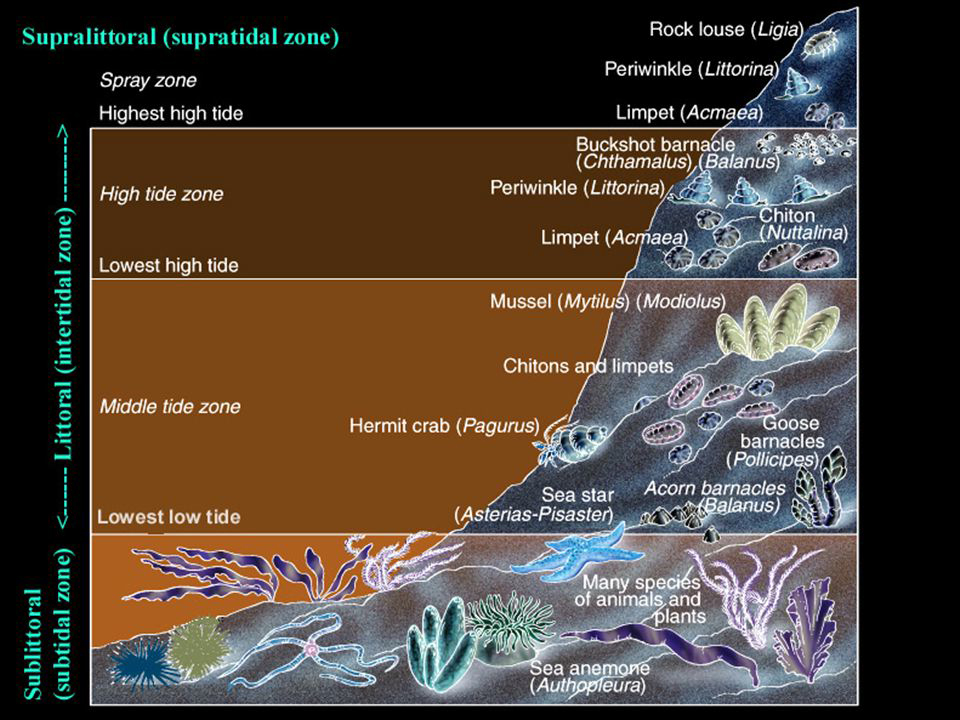On a field trip with students to the Pacific Coast, ecologist Robert Paine discovered a thriving community of aquatic organisms at Mukkaw Bay, at the tip of the Olympic Peninsula. The tide pools were full of green anemones, purple sea urchins, pink seaweed, bright red Pacific blood starfish, as well as sponges, limpets, and chitons. At the low tide rocky surfaces exposed bands of small acorn barnacles, and large, stalked goose barnacles, beds of black California mussels, and some very large, purple and orange starfish, called Pisaster ochraceus.
In 1963, Paine returned to Mukkaw Bay. During low tide, using a crowbar he removed every Pisaster starfish on the exposed rock surfaces and threw them far into the bay. This was the humble beginning of a highly influential experiment that will find a legendary niche in the history of ecology. The experiment was going to seek answers to questions such as why herbivores don’t eat all the food provided by the primary producers? This was called the Green World hypothesis.
Echinoderms: Sea Star Time-lapse: Pycnopodia Chases Snails from Shape of Life on Vimeo.
The Green World Hypothesis is now widely known as trophic cascade. The concept was championed by three ecologists Nelson Hairston, Frederick Smith and Lawrence Slobodkin (HSS hypothesis) in 1960. They suggested that predators keep herbivore populations in check by consuming them. However today we know that this is not the entire reason why the world is green. Plants have evolved chemical and physical defenses against herbivory as well. These defenses reduce the quality of plant tissues for herbivores and can even kill, directly or indirectly.
In Africa when leopards decline baboon populations grow and start attacking farms. Similarly when predators disappear as a survival response plants are forced to evolve defensive thorns and bitter chemicals known as secondary compounds. Thorny Acacia trees are more common in areas where impala experience a low risk of predation by wild dogs. A related Acacia, without thorns, is most abundant in areas where risk of predation is high, and so the number of hungry impala is low. Some plants have biological alliance with ants to reduce herbivory.
HSS conceptualized the food chain containing hierarchical levels. The decomposers were at the bottom degrading organic debris. The producers were above them, relying on sunlight, rain, and soil nutrients for photosynthesis. Higher up were the consumers, the herbivores that ate plants; and above them the predators that ate the herbivores.
The ecologists during that time assumed that each level limited the next higher level. In other words, populations were positively regulated from the “bottom up.” But HSS drew attention to the observation that herbivores generally do not completely consume all of the vegetation available. Herbivores were not food-limited. They suggested that predators could be regulating herbivore populations from the “top-down” in the food chain. In those times, it was generally thought that the availability of prey regulated predator numbers in a “bottom-up” fashion. For instance, mule deer (Odocoileus hemionus) population in Northern Arizona increased after extermination of wolves and coyotes. Paine’s findings in Mukkaw Bay was confirming the top-down control predators could exert.
Only three months after Paine began removing the starfish, the acorn barnacles had spread out to occupy 60 to 80 percent of the rock surfaces. A year into the experiment, the acorn barnacles were in turn being crowded out by small, but rapidly growing goose barnacles and mussels. Four species of algae, two limpet and two chiton species had vanished from the rock surfaces. The anemone and sponges had also decreased. On the other hand, population of one small predatory snail, Thais emarginata, increased 10- to 20-fold. Altogether, the removal of the predatory starfish had quickly reduced the species of the intertidal community from 15 down to eight.
Echinoderms: Sea Star Time-lapse: Eating Mussel from Shape of Life on Vimeo.
In a different study, Paine and zoologist Robert Vadas removed or excluded all of the urchins from some pools around Mukkaw Bay. They left nearby pools and areas as is that served as controls for their experiment. They observed dramatic effects of removing the sea urchins—several species of algae burst forth in the urchin-free zones. The control areas with large urchin populations contained very few algae.
Observations suggested that the reintroduction of sea otters would lead to a dramatic restructuring of coastal ecosystems. Shortly after their pioneering study, sea otters began to spread and re-colonize along the Alaskan coast. In 1975, sea otters were absent from Deer Harbor in southeast Alaska. But by 1978, the animals had established themselves there, sea urchins were small and scarce, the sea bottom was littered with their remains, and tall, dense stands of kelp had sprung up.
The presence of the otters had suppressed the urchins, which had otherwise suppressed the growth of kelp. This kind of double negative logic is widespread in biology. In this instance, otters “induce” the growth of kelp by repressing the population of sea urchins. The discovery of the regulation of kelp forest by sea otter predation on herbivorous urchins was very strong support for the HSS hypothesis and for Paine’s keystone species concept.
Another test of the Green World Hypothesis came from a number of islands that became isolated after a large dam construction in Venezuela. Islands that lack the predators suffered in terms of plant diversity.
Cnidarians: Anemone Swims Away From Sea Star from Shape of Life on Vimeo.



1 Comment